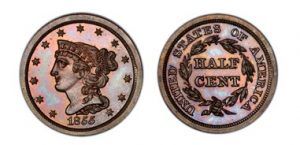The Modern Look of the Braided Half Cent
Posted onThe Braided Hair Half Cent is one of the most collectable coins ever issued by the US Mint.
The coin, first minted in 1793, was the smallest denomination ever minted and is part of a series consisting of five major types and subtypes which are each part of a series of varieties. This vast array presents collectors with an opportunity to own a diverse set of coins that are all within the same family.
The Braided Hair Half Cent was the last of the varieties and is largely the work of Chief Engraver Christian Gobrecht who evolved the design from the Classic Head image to the more youthful braided hair look.
Officials authorized the coin as part of the Coinage Act of 1792. The US minted the coin, which consisted of 100% copper, between 1793 and 1857. The coin carried a value of just one two-hundredth of a dollar. It was nearly the size of today’s quarters.
The first variety was the Liberty Cap showing Lady Liberty’s profile facing left. Henry Voigt designed and engraved the piece. Following this coin was the Liberty Cap variety issued just one year later. Chief Engraver Robert Scot designed the imagery. Scot is also remembered for designing the famous Draped Bust coin and Flowing Hair dollar. His Liberty Cap design continues until 1797 when engravers Gilbert Stuart, and Scot-John Gardner worked with Robert Scot to create the Draped Bust design. The US Mint issued this version in 1800 and continued to mint it until 1808.
The last version to be designed before the Braided Hair issuance was the Classic Head minted from 1809 to 1836. The Classic Head has a strong resemblance to the Braided Hair that follows. Lady Liberty’s profile faces left and has a hair style that is somewhat similar to the Braided Hair coin first issued in 1840.
The US Congress officially ended the minting of half cent coinage with the Coinage Act of 1857. This decision was the result of a shifting economic setting in which the value of the coin was less than the cost of production. Moreover, the utility of a half cent was too low for most consumers. Towards the end of their run the coins were valued more for their metal content than their buying power.
Today the coins are one of many enduring works from Gobrecht who was born in Hanover, Pennsylvania and got his start as a watchmaker apprentice. This introduction into fine craftsmanship is what ultimately led him to the engraving work that he is remembered for. One of his works even carries his name, the Gobrecht dollar, struck from 1836 to 1838, is a beautiful piece showing Liberty in a seated position with a shield.
His work appeared on almost every denomination from the US Mint. He was Chief Engraver for four years. He died in 1844.
The mint quantities for the Braided Hair half dollar were low with the highest minting reaching only 147,672 pieces in 1851. The majority of the other issues were in quantities of approximately 50,000.
Want to read more? Subscribe to the Blanchard Newsletter and get our tales from the vault, our favorite stories from around the world and the latest tangible assets news delivered to your inbox weekly.







